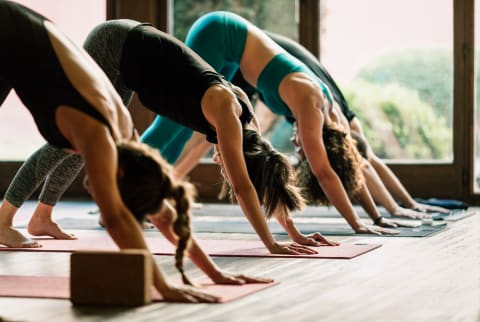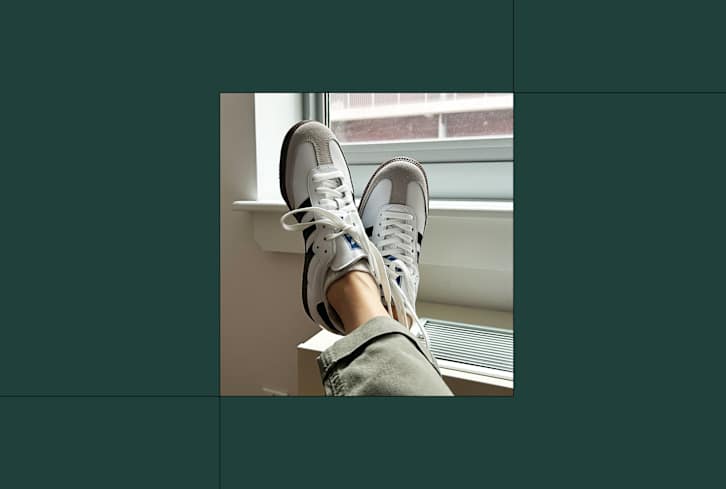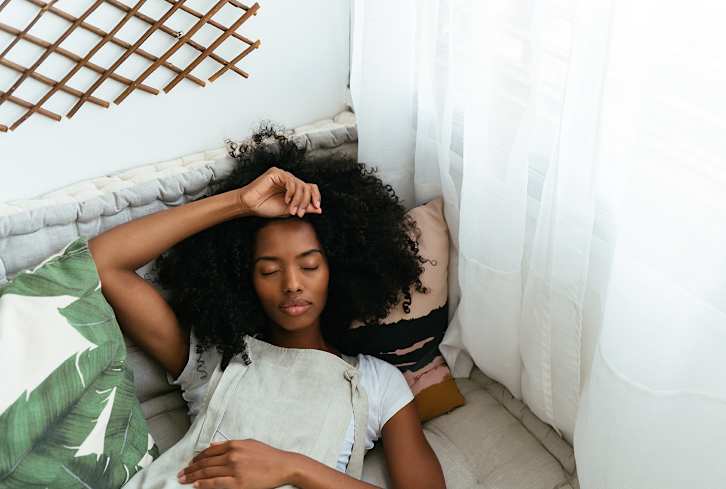Advertisement
I've Been Doing Yoga 3-4x A Week For The Past Year—Here's What I've Noticed


Yoga, like any good habit or routine, takes consistency in order to reap the benefits. I've been practicing yoga for years, but it was only in the past year that I've been consistently practicing three to four times a week.
I have my yoga teaching schedule to thank for that, which gets me into the studio to teach hourlong Vinyasa classes on Tuesdays, Thursdays, and Saturdays. I do the poses with the students as I teach, and on a good week, I'll take at least one class as a student myself.
And after a whole year of consistent practice, I can honestly say I've never felt stronger or more grounded in my body. Here are the benefits I've felt firsthand, plus my go-to yoga poses for improved mobility, strength, and posture:
Increased shoulder mobility
So many people suffer from rounded shoulders, tight pecs, stiff necks, and upper back pain. I did too, with frequent tightness on my right shoulder that would run up into my neck, sometimes causing tension headaches!
But over the past year, I've been practicing plenty of neck and shoulder stretches, including simple neck-release stretches, thread-the-needle, and shoulder rotations.
Not only do I rarely get that stiff shoulder pain anymore, but my upper back and neck are less rounded, and when I open my arms out to the side, I can feel that my chest is way more open and loose as well.
Better core strength
I always start my yoga classes with a few staple core exercises to get the abdominal muscles warmed up and activated.
It's no secret that good core strength helps improve posture by way of supporting your upper body and taking pressure off the low back, and I've felt those benefits firsthand this past year. I've especially seen benefit with functional core moves that work the deep, low abdominals that can be hard to reach (i.e., planks and hollow holds instead of just situps).
Not only has strengthening my core helped support my overall posture, but I just feel stronger and more confident when I carry myself.
Open hips
As my core got stronger this past year, I noticed it helped me stand up a bit straighter, but that made me realize my hip flexors were tight. To support the newfound openness and strength on the front side of my upper body, I had to address the lower half of my body too.
This led me to (pretty intensely) focus on opening my hips and stretching out my hip flexors. For a few months, I was hellbent on stretching the fronts of my thighs and counteracting the effects of sitting—and I did!
Where my hips were once constantly stuck in flexion (upper body leaning slightly forward at the hips), I can now stand tall with my hips forward, joints stacked, and my weight fully supported.
Increased foot mobility
This one might sound silly, but you'd be amazed how many problems can start down at your feet and run up the body, causing ankle pain, knee pain, hip pain, low back pain, and yes, even shoulder pain.
Our joints are designed to stack and support our weight, but if our weight isn't evenly distributed through our feet, we don't have the proper foundation set.
For me, this looked like pronating heavily on my right foot (placing more weight on the inside of the foot), which caused the whole right side of my body to be out of alignment. Now that I think about it...that could've been contributing to the aforementioned shoulder pain on my right side—but I am certain it contributed to knee pain.
So now, I always do foot mobility drills before balancing postures, fanning out my toes and stretching my feet and ensuring I'm distributing my weight evenly.
If your big toes point inward from wearing shoes all the time, let me tell you—mine did too. But I've been doing these foot exercises so often that they are literally changing the shape of my feet. My big toes point less and less inward, and it's improved my stride, plus reduced pain.
Better posture
I touched on this benefit already, but I'll say it again: Consistent practice over the past year has helped improve my posture in so many ways.
With my chest more open and shoulders relaxed back, I can sit up straight without difficulty or much effort, and the increased core strength helps with that too.
Going back to the idea of stacked and supported joints, I finally know what it really means to stand tall, and all of my yoga postures just feel more right.
Reduced pain
A majority of my aches and pains have historically been on the right side of my body. As I mentioned, my right knee and right shoulder have given me a bit of trouble, as well as my right-side hip and low back.
And I'll never stop singing the praises of yoga because with the right postures—and consistency!—I've been able to dramatically reduce that pain.
Again, this is where a regular practice is essential; if I have to get one of my classes covered and I'm off my usual schedule, I can feel it immediately. If I go more than two days without doing yoga, stiffness starts creeping back in and I know it's time to get back on the mat. And just like that, I'm all loosened up again!
Greater mental fortitude
Last but definitely not least, the benefits of a regular yoga practice are not just physical. To say my yoga practice has been a journey of self-exploration isn't an overstatement. In fact, it is written in the Bhagavad Gita that, "Yoga is the journey of the self, through the self, to the self."
Getting through a yoga class (especially a hot yoga class) isn't just about physical strength, endurance, and flexibility. It takes mental fortitude, focus, concentration, will, and equanimity. I've been forced to confront myself on my yoga mat and have realized it is our minds, and our reactions to our minds, that create the experiences we have in class.
Eventually, I further realized my mind creates the experiences I have outside of class as well. And the more I've honed that mental fortitude and equanimity, the more I can handle any challenge, difficulty, or emotional trigger with ease—on or off the mat.
These are the postures that have helped me get there
Want to experience these yoga benefits yourself? Here's a pose for each benefit listed above to try—just remember to be consistent!
- For shoulder mobility, try thread-the-needle: Starting in tabletop, inhale and reach your right arm up, feeling for opening up the right side of the chest. Fan your right arm down under your left as you exhale, and give yourself a hug on your left shoulder. Inhale your right arm back up, and exhale to hug yourself again. Inhale one more time up, and exhale all the way down to thread the needle. Hold for a few deep breaths, then repeat on the opposite side.
- For core strength, try flutter kicks: Lying on your back, place your hands with palms down under your low back. Press your lower back down into your hands with your chin tucked in toward your chest, and alternate quickly fluttering both legs. Keep going for at least 30 seconds.
- For open hips, try weighted glute bridges: Turn up your regular bridge pose with a dumbbell, holding it from either side on top of your hips. Come up into your bridge pose and feel for your knees stretching away from your hips, lengthening out the quads. Hold for at least 30 seconds.
- For foot mobility, try toe fan stretches: Standing in mountain pose or seated in a chair, fan your toes out as wide as you can and press your big toes down while lifting your four little toes up. Then, switch it, pressing your four little toes down and lifting your big toes up. Alternate back and forth for at least 30 seconds.
- For better posture, try goalpost arm rotations: Take goalpost arms (elbows bent at a 90-degree angle in line with the shoulders, palms facing forward). Inhale to draw your palms back, keeping elbows in line with the shoulders, feeling shoulders draw in and down toward your hips. Then, exhale to bring your forearms to touch in front of your face, feeling shoulders open. Inhale to open back up again, repeating for 3-5 rounds.
- For reduced pain, try figure-4 stretch: Target your hips and low back with a figure-4 stretch, either lying on your back or seated in a chair. Cross your right ankle on top of your left thigh and press in, dropping your right knee out to stretch the outer edge of the hip and low back. Hold for at least 30 seconds, then repeat on the opposite side.
- For mental fortitude, try hot yoga: Not one single pose, but one hot room! The postures in a hot yoga class are challenging, yes, but the heat is what takes mental acuity. Knowing that you can stand the heat if you only stay calm and keep breathing will translate to so many areas of your life. Trust me!
The takeaway
If I had known just how good I could feel from a diligent yoga practice, I would have been way more adamant about being consistent in the past. But now that I do know, I'll never go back!
Take it from me—and from all the people throughout history who have trusted yoga to keep them physically, mentally, and spiritually balanced: It can do actual wonders for your body, as well as your mind and soul, so make a point to give yourself the gift of a regular practice.











